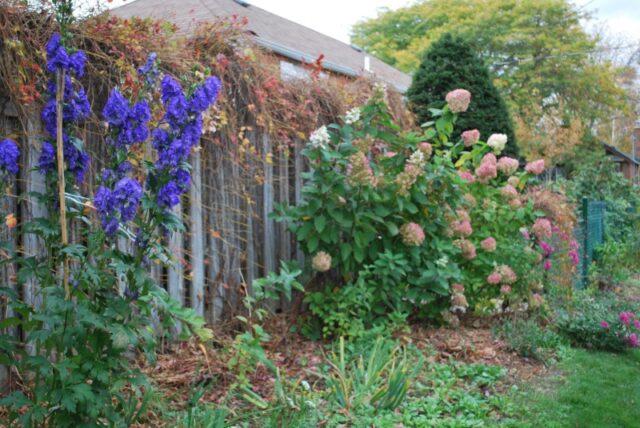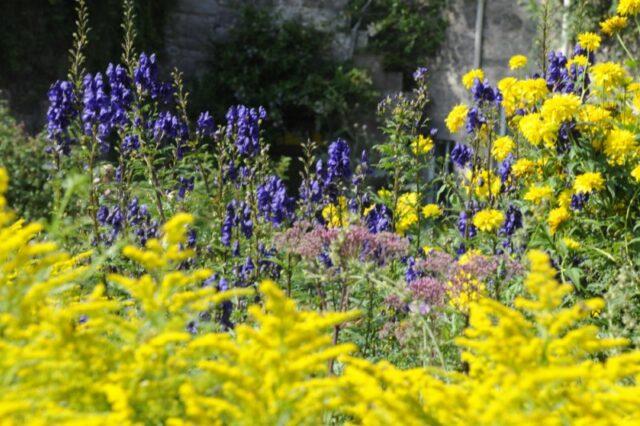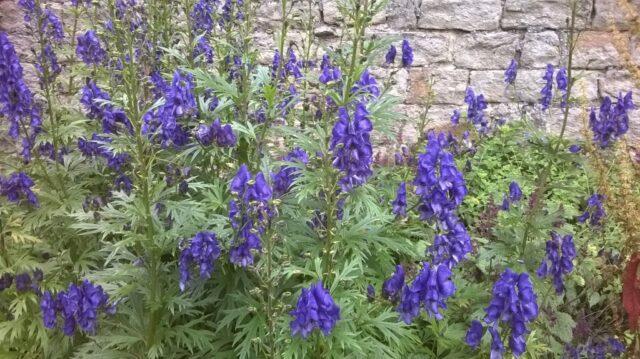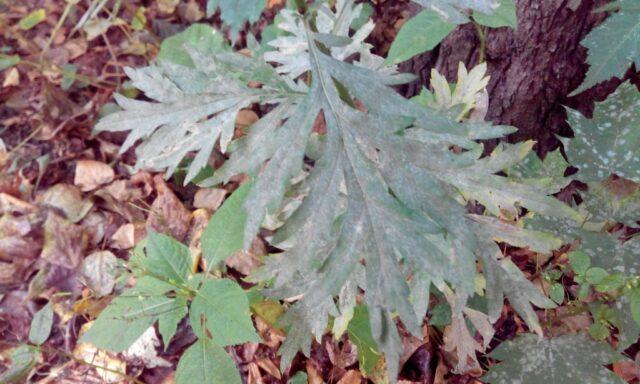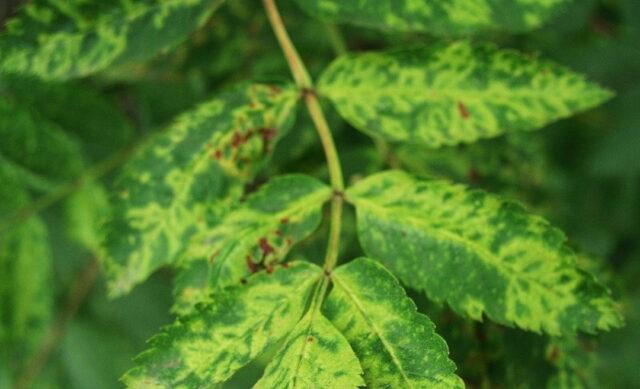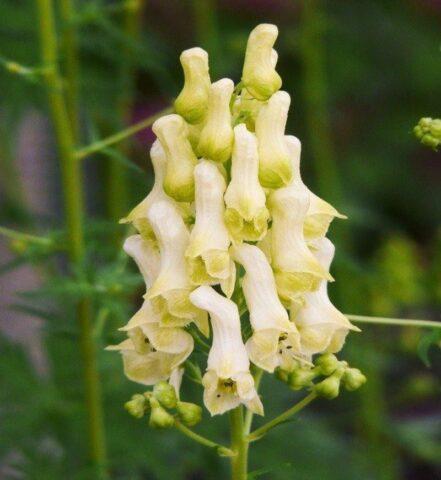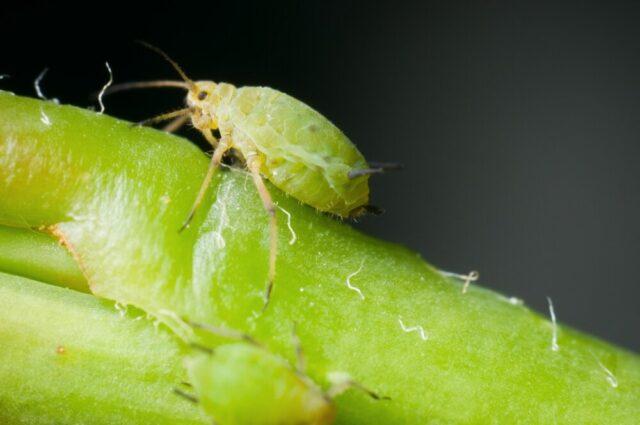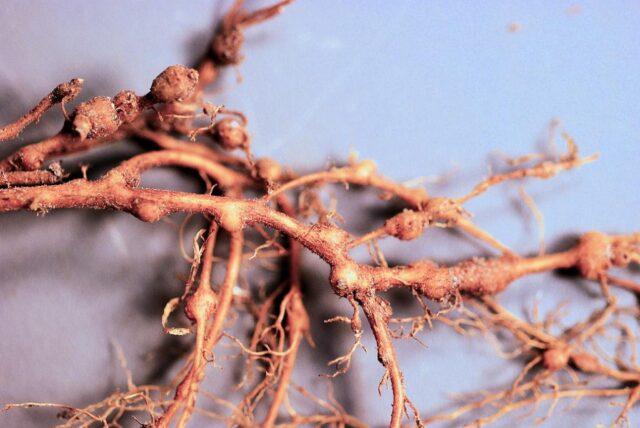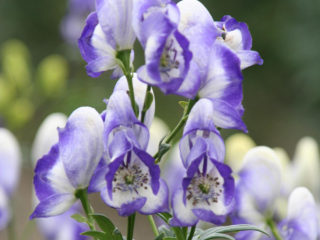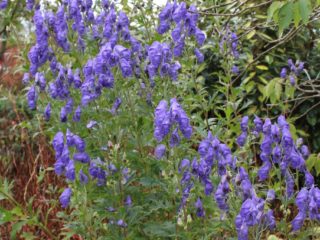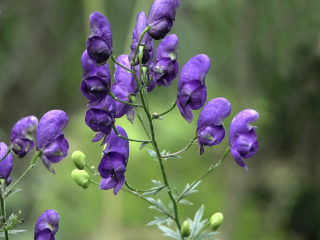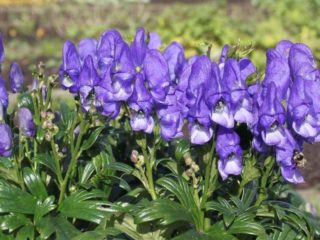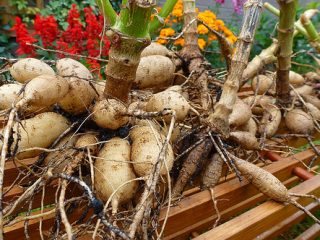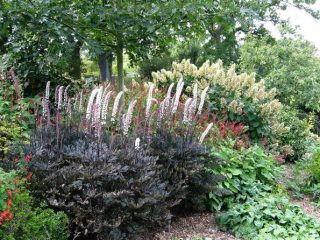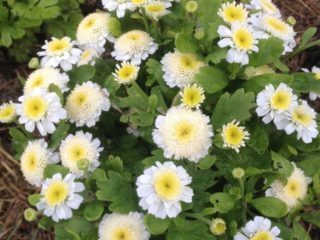Content
- 1 Description of the plant aconite
- 2 Types and varieties
- 3 Caution: aconite is a poisonous plant
- 4 Aconite in landscape design
- 5 Features of the reproduction of aconite
- 6 Planting and caring for aconite in the open field
- 7 The composition and value of the plant
- 8 The healing properties of the herb aconite
- 9 The use of aconite in traditional medicine
- 10 Poisoning symptoms and first aid
- 11 Limitations and contraindications
- 12 Collection and procurement of raw materials
- 13 Conclusion
The aconite plant belongs to the category of extremely poisonous perennials. Despite this, the flower has a decorative value and is used in folk medicine in minimal dosages.
Description of the plant aconite
Aconite is a whole genus of poisonous herbaceous plants from the Buttercup family. The flower is characterized by straight stems and rounded, palmate, strongly dissected leaves of a rich green hue. A perennial grows on average up to 60 cm.
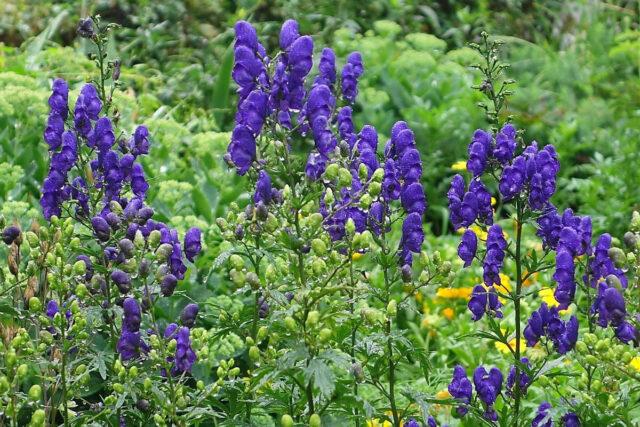
The tallest specimens of aconite can reach 2 m
As can be seen from the photo and description of the aconite flower, the plant bears large apical clusters, consisting of bell-shaped buds, similar to overhanging helmets or hoods. The color is blue, purple, lilac, as well as white or yellow. Aconite dissolves in the second half of summer and can bloom until autumn.
What's the difference between aconite and wrestler
The wrestler is the second name for aconite. There is no difference between the concepts. The plant can also be found under the names of skullcap, lumbago grass and wolf root, but much less often.
Where does aconite grow
Aconite is widely distributed throughout the world. You can meet him in North America and Central Asia, in Europe and in Tibet, in Mongolia and Pakistan. In Russia, it grows in Western Siberia and Altai, in the forest zone of the middle zone. The wrestler is very hardy, some species are found even in the arctic climate.
Types and varieties
The aconite plant in the Northern Hemisphere is represented by several hundred species, 75 of which can be found in Russia. It is helpful to familiarize yourself with the most common wrestler varieties.
Altaic
Altai Aconite (Aconitum altaicum) reaches an average of 1.5 m in height. The plant has shiny green dissected leaves and produces deep blue buds, collected in large inflorescences. The wrestler dissolves in late June or early July and retains its decorative effect for about 20 days.
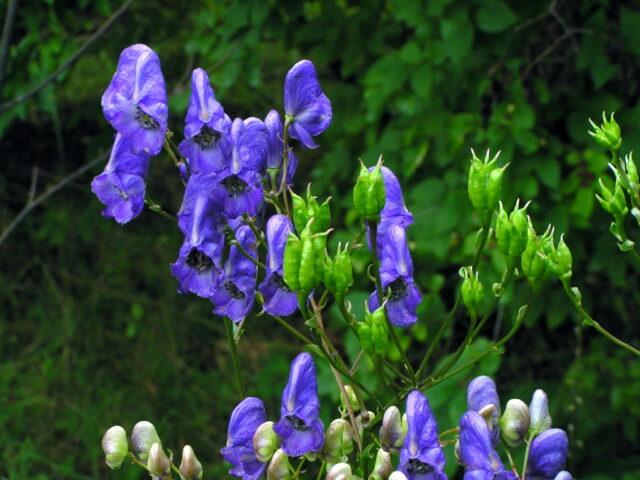
Altai species of aconite can bloom again in early autumn
Curly
Curly aconite (Aconite volubile) has a thin twisted stem about 2 m long. It belongs to the climbing species, it can wrap around not only supports, but also neighboring plants in the garden. It grows most abundantly in the south of Siberia and the Far East. The dark blue buds of the wrestler are represented by very large inflorescences - up to 100 cm long.

Curly aconite blooms at the end of July and can retain its decorative effect for about 45 days.
Klobuchkovy
The napellus, or blue, aconite (Aconitum napellus) bears rich azure flowers, shaped like a monk's cowl. The plant rises in height by an average of 1.5 m, and begins in the period of decorativeness from July.
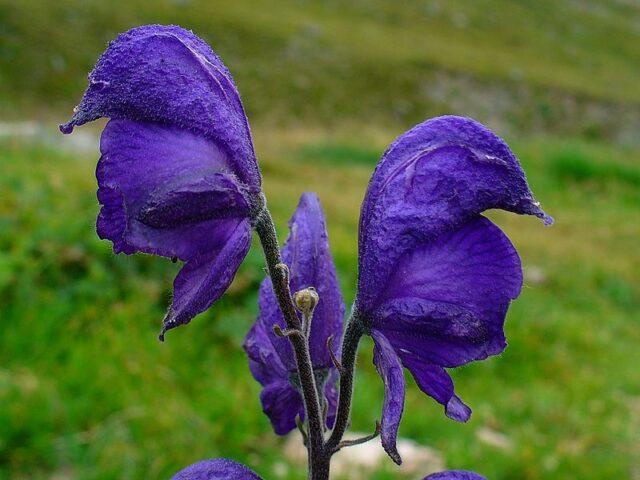
Nodule aconite is especially widespread in the middle lane
Fisher's Aconite
Fisher's Aconite (Aconitum fischeri) grows mainly in the Far East in deciduous and mixed forests. The plant usually grows up to 1.6 m, from July it brings bright blue, sometimes white buds.
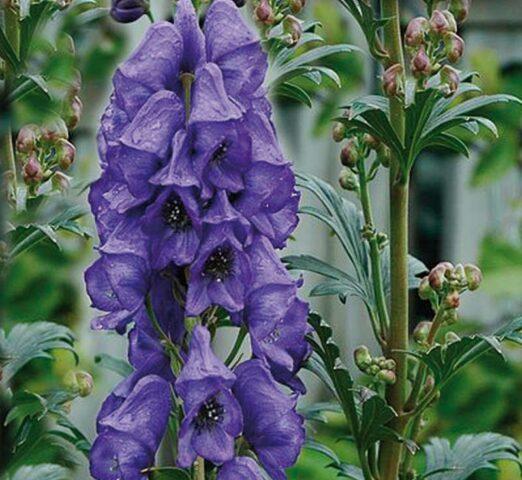
The flowering of Fischer's aconite continues until October.
Motley
Aconite variegated (Aconitum variegatum) is common in the European part of Russia. It is a tuberous plant with dense dissected leaves, blooms from mid-July. The buds of a wrestler of this species are blue or dark blue, up to 2 cm wide.
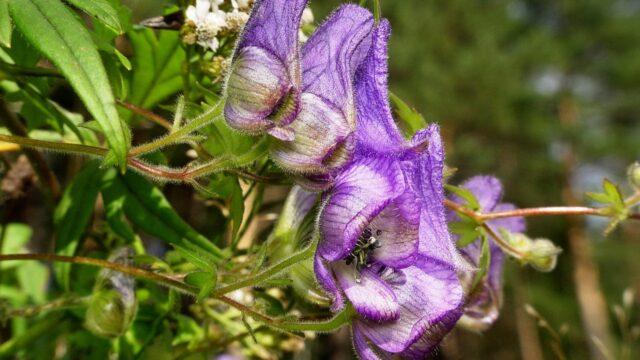
Variegated aconite has been cultivated since 1584
Bearded
The bearded aconite (Aconite barbatum) rises about 1.2 m above the ground. The stems of the plant are straight, slightly pubescent, the leaves are dissected into narrow slices to the base. In the middle of summer, the wrestler brings sulfur-yellow buds.

Bearded aconite grows mainly in the Far East and Siberia
Tall
Aconite tall (Aconitum septentrionale) is able to rise on a thick stem up to 2 m. It opens in mid-summer at standard times, widespread in the middle lane. The flowers of this type of wrestler are purple.
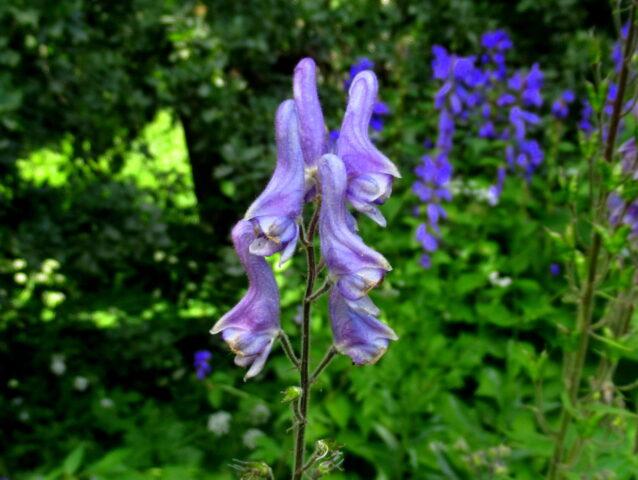
High aconite is actively cultivated as a cultivated plant
Dzungarian
Dzungarian aconite (Aconitum soongaricum) is widespread in Kazakhstan and Kyrgyzstan. It grows up to 1.3 m, the stem of the wrestler is straight and strong, with pronounced pubescence. A photo and description of the aconite plant report that in the second half of summer, the species brings large blue-purple buds up to 4 cm long.
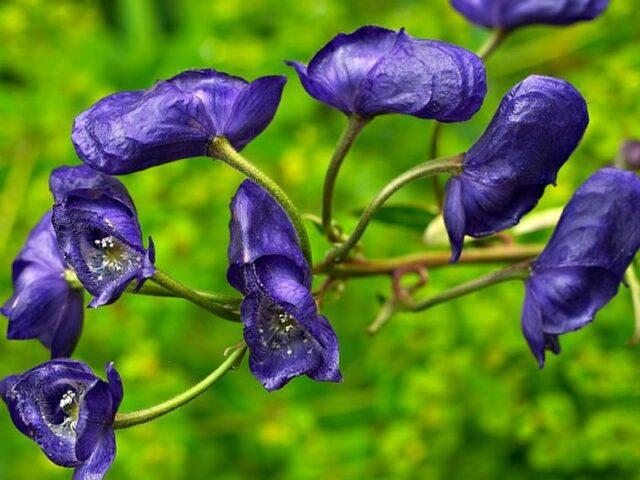
Dzungarian aconite can be found exclusively on the northern slopes of the mountains, on moist soils
Antidotal
The antidote aconite (Aconite anthora) is a perennial up to 1 m tall. The leaves of the plant are ovoid, repeatedly dissected, the flowers are yellow and large. The species is very decorative, a characteristic feature is good survival rate after transplantation in adulthood.
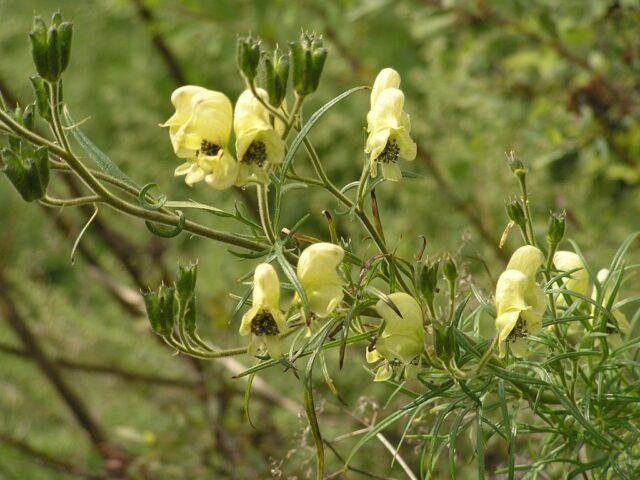
The antidote fighter is also called antoroid
Dubravny
Aconite oak (Aconitum nemorosum) grows exclusively in chernozem regions on the steppe slopes and in deciduous forests. The flowers of the species are pale yellow, appear in July and August. The plant rises no more than 60 cm.

Even on nutritious moist soils, oak aconite grows very slowly.
Northern
Northern aconite (Aconitum excelsum) is found in the European part of Russia and in cold regions, mainly in forests. The flowers of the plant are lilac or whitish, sometimes white. The decorative period begins at the usual time - in the middle of summer.
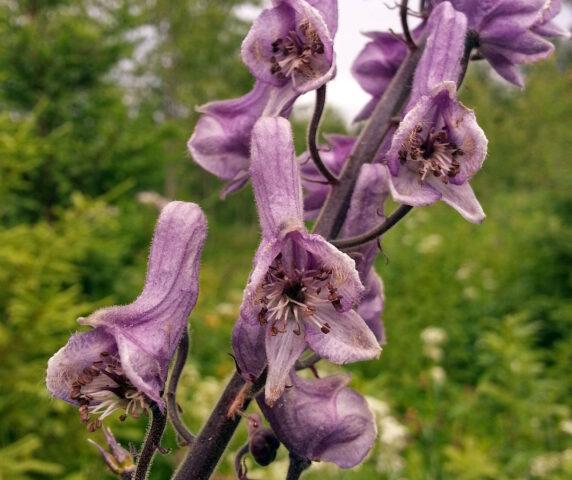
In height, the northern wrestler is capable of reaching 2.5 m
Baikal
Aconite Baikal (Aconitum baicalense) has a dense, straight stem and green, hairless leaves, cut into five parts. The wrestler blooms with loose tassels, consisting of dark purple buds only about 1.5 cm long. The plant blooms in July.
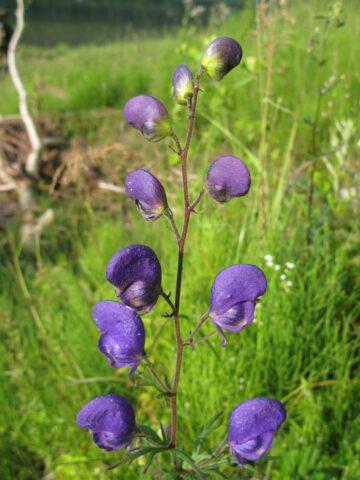
Baikal aconite plant rises up to 1 m above the ground
Arcuate
Arcuate, or winding aconite (Aconitum arcuatum) is found mainly in the forests of the Far East. It is a liana-like plant up to 2.5 m tall, popular in cultivation. The wrestler blooms from the beginning of August with dark blue buds.
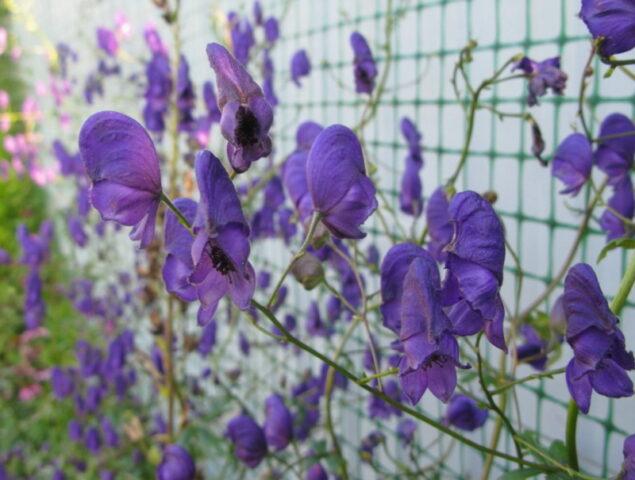
Arcuate aconite is able to maintain an attractive appearance in the garden until the very frost
Caution: aconite is a poisonous plant
The wrestler is very poisonous. It contains numerous alkaloids and acids hazardous to human health, aconitine and hypoaconitine, coumarins and tannins. Severe poisoning with aconite can be fatal in just 20 minutes, so you need to handle the plant very carefully.
All types of wrestlers are poisonous to one degree or another - there are no varieties that are safe for animals and humans.Among the most toxic are:
- Dzungarian;
- Fisher;
- Baikal;
- bearded;
- northern;
- Korean;
- curly;
- Amur.
It is believed that European plant species and ornamental wrestler varieties contain less toxic substances than wild perennials from the southern and eastern regions. However, they still remain very dangerous to humans.
It is necessary to work with aconite only with tight gloves, it is desirable to protect the eyes and respiratory organs. It is strictly forbidden to touch the face after contact with the sap of the plant. Upon completion of work, hands should be thoroughly washed with soap and water.
Aconite in landscape design
Despite the toxicity of aconite, gardeners appreciate its attractive appearance. A tall plant with large buds and long flowering attracts attention and adorns almost any site.
In landscape design, aconite is used:
- for decorating fences and gazebos;
Tall aconite enlivens the space around fences and walls
- to form contrast in flower arrangements;
Aconite looks great in single and group plantings
- to decorate empty areas.
Aconite can be planted in the far corner of the garden, where it will not interfere and revive the space.
Aconite goes well with other perennials - daylilies, chamomiles, irises and peonies.
Features of the reproduction of aconite
The wrestler plant is propagated in several ways:
- By dividing the bush... The procedure is carried out for adult specimens approximately once every four years. In the process, the plant is buried in and the rhizome is cut with a sharpened shovel, leaving at least three growth buds on each division. Then the seedling is transferred into a previously prepared hole, sprinkled with soil, mulched and watered.
- By cuttings... In mid-May, several shoots about 15 cm long are cut into an adult wrestler and germinated in a mini-greenhouse. After the appearance of the first leaves, aconite is transferred to open ground.
- Seeds. The wrestler plant is sown in the fall directly into the soil for natural stratification. From above, the planting material is sprinkled with a layer of manure for insulation. In the spring, after the snow melts and the ground warms up, young aconite will give its first shoots.
- Tubers... When propagating in this way, it is necessary to germinate the planting material at home or in greenhouse conditions to several buds, and then transfer it to the ground.
The seed method of breeding a wrestler is used relatively rarely. It is inconvenient to cultivate varietal plants with its help, since the unique characteristics are usually not preserved.
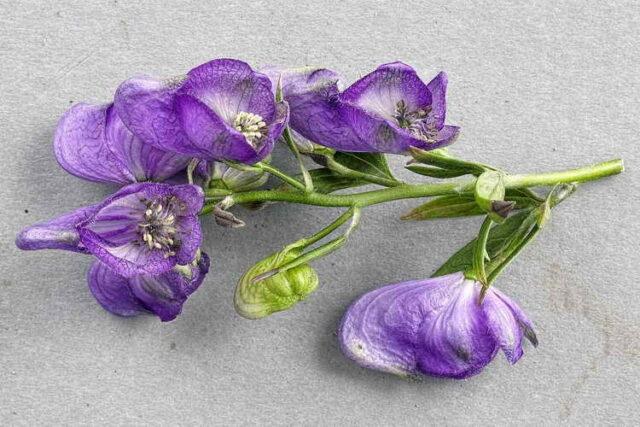
Aconite lends itself easily to vegetative propagation and takes root quickly
Planting and caring for aconite in the open field
The wrestler is a fairly hardy plant. It is suitable for cultivation in the middle lane, in the north and in the southern regions.
Timing
With seed propagation, the aconite plant is planted in open ground in the fall a few weeks before the cold weather. It is possible to transfer wrestler's cuttings or cuttings to the ground throughout the growing season, but it is best to do this in spring or until mid-October.
Site and soil preparation
The wrestler plant feels equally well in sunny areas and in partial shade, it can develop, including under large trees or near the walls of buildings. The main attention should be paid to the soil, it should be aerated and nutritious, sufficiently moist, but not swampy.
A few days before planting aconite, you need to dig a hole approximately twice the size of the tuber or root system of the plant. Lean soils are enriched with compost or humus, and heavy and clayey soil is diluted with pebbles and rubble. Half the hole is covered with a mixture consisting of garden soil, peat and sand in equal amounts, and 20 g of complex mineral fertilizers are added for the wrestler.
Landing algorithm
Planting aconite is not particularly difficult.The tubers of a plant with a large bud and roots, sprouted cuttings or cuttings are lowered into a prepared hole and sprinkled with the rest of the soil. At the same time, it is not necessary to deeply deepen the wrestler, otherwise it will be difficult for him to develop. When planting cuttings and cuttings, it is important to ensure that the root collar does not go underground.
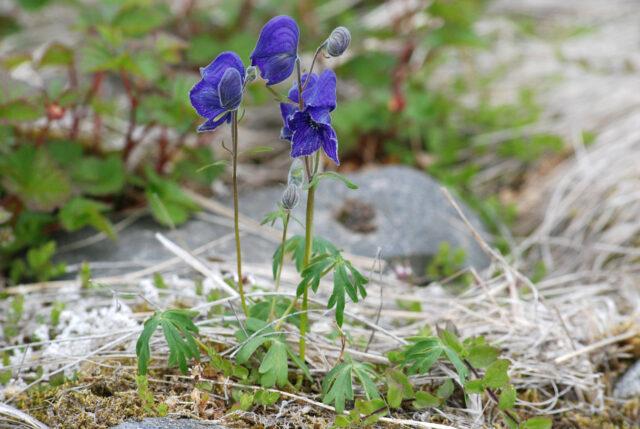
The soil at the roots of aconite can be mulched with straw
Immediately after planting, the plant is watered abundantly. It is necessary to leave gaps of at least 20 cm between individual copies.
Watering and feeding schedule
Despite the unpretentiousness and endurance of the wrestler plant, for good flowering it needs regular feeding:
- For the first time, fertilizers are applied in the spring at the beginning of the growing season - the perennial is watered with infusion of bird droppings or mullein for rapid growth.
- The second feeding of the plant with nitroammophos is carried out when buds appear.
- For the third and fourth time, the wrestler is fertilized during the summer with dry potassium and phosphorus.
The interval between dressings should be about 25 days. It is not recommended to use ash for aconites, it lowers the acidity of the soil, and this is undesirable for the plant.
As for watering, the wrestler is moistened as needed, on average twice a month in dry weather. The plant should not be poured, the soil should remain well ventilated.
Weeding and loosening
After each watering, the soil under the plant must be loosened. Otherwise, the surface layer of the soil will turn into a crust, which will prevent oxygen from reaching the root system. At least once a month, it is recommended to weed the soil from weeds, they take away nutrients and moisture from aconite.
Wintering
Most species of aconite plant tolerate winter cold well, but perennials still need to be insulated. With the onset of frost, the grass is cut off almost flush with the ground, after which it is covered with a layer of peat about 10 cm. On top, spruce branches or fallen leaves are additionally laid.
Diseases and pests
Some fungal diseases pose a danger to the wrestler. Among them:
- powdery mildew - the fungus leads to the rapid wilting of the plant;
When affected by powdery mildew, the stems and leaves are covered with a whitish bloom.
- ring mosaic - a viral disease is carried mainly by aphids, cannot be treated;
With mosaic viruses, plant leaves are covered with yellow or brownish patterns and spots.
- greening flowers - another virus deforms the buds of aconite and changes their shade.
With viral greening, even blue aconite becomes greenish yellow and white.
Fungal ailments of the wrestler plant are well eliminated by the fungicides Skor and Fundazol, as well as solutions of potassium permanganate and garlic. With incurable viruses, it is important to think about healthy neighboring plantings, it is for this reason that the affected specimens are urgently burned.
The aconite plant in the garden can also suffer from pests. The greatest danger is posed by:
- aphid - a small insect reproduces in large colonies and can be quickly destroyed by a wrestler;
Aphids feed on the sap of flowers and leaves of aconite
- nematodes - small worms usually infect the root system of the plant, and then cause deformation of the stems and leaves.
Nematodes are dangerous because they are recognizable in the early stages.
To eliminate parasites, special preparations allow - Aktara, Phosphamide, Conifor and others. If the plant is slightly infested, you can use a homemade soap solution.
The composition and value of the plant
Aconite contains not only dangerous toxins, but also useful elements, this is due to its medical value. In particular, the wrestler plant contains:
- tannins and saponins;
- coumarins and resins;
- fumaric, benzoic and citric acids;
- daucosterol and mesainodizole;
- chromium, selenium, lead and barium;
- oleic and myristic acid;
- inositol;
- stearic acid;
- potassium and chromium;
- Sahara;
- alkaloids;
- zinc and copper;
- flavonoids;
- starch;
- boron and nickel;
- vitamin C;
- magnesium and iron.
When used carefully in meager dosages, the healing properties of the wrestler, or aconite, can help with many diseases.
The healing properties of the herb aconite
Due to its rich chemical composition, the plant has numerous healing properties. In particular, the herb:
- fights bacterial processes and reduces fever;
- helps with inflammation;
- has a calming effect in case of stress;
- promotes expectoration;
- stops bleeding and helps with diarrhea;
- serves as a good diuretic.
The plant contains natural hormones, so you can use it with a lack of estrogen.
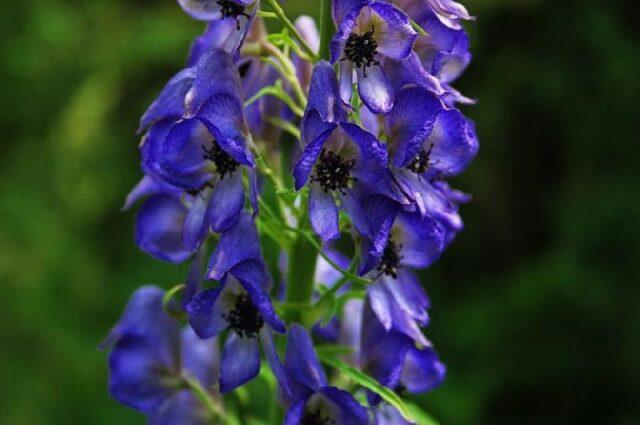
Aconite is known as a powerful natural pain reliever
The use of aconite in traditional medicine
Poisonous aconite is used for medicinal purposes in both folk and official medicine. It is used mainly by external methods, in some cases, internal use of drugs is allowed. The plant brings benefits when:
- purulent infections and skin parasites;
- disorders of the nervous system;
- diseases of the joints and spine;
- abscesses;
- neuralgia and rheumatism;
- syphilis;
- oncological tumors.
Recipes
Traditional medicine offers recipes for several effective remedies based on aconite. Each of them contains a maximum of valuable substances.
Decoction
An aqueous decoction of the wrestler plant is prepared according to the following recipe:
- a small spoonful of dry root is poured with 250 ml of boiling water;
- Keep in a water bath for 15 minutes;
- cool under the lid for 45 minutes;
- filtered.
You need to use the product in a small spoonful on an empty stomach three times a day. The plant-based drug is stored for no longer than three days, even in the refrigerator.
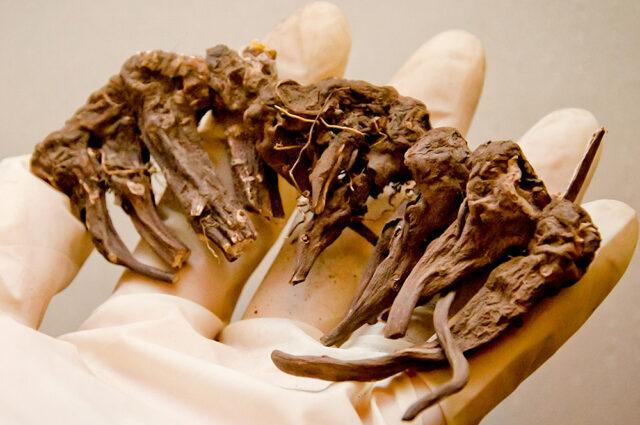
The maximum amount of valuable substances is concentrated in the roots of aconite
Tinctures
There are two main recipes for making an alcoholic tincture of the aconite plant. For external use, make the following remedy:
- 50 g of dry roots are poured with 250 ml of vodka;
- insist under the lid for 14 days;
- passed through cheesecloth from the sediment.
The finished product from the wrestler should have a dark brown color of strongly brewed tea. A tincture of the plant is used for rubbing with rheumatism, tuberculosis and muscle pain. You can use no more than 15 ml of the product for application to the skin, and in the presence of heart ailments - only 5 ml.

Alcohol tincture of the fighter helps with arthrosis
If you use the tincture of the plant to be inside, use a different recipe:
- 10 g of aconite root is poured into a glass of vodka;
- insist in a dark place for a week, shaking from time to time;
- filter through cheesecloth.
Such a remedy is taken just drop by drop, up to three times a day, the healing fighter must be diluted in 50 ml of water.
Ointment
For joint ailments, headaches and myalgia, a homemade ointment based on the aconite plant helps. They do it like this:
- 10 g of fresh root of the wrestler is crushed and 100 ml of vinegar is poured into a container with a narrow neck;
- put in a water bath and evaporate over low heat until the liquid darkens;
- add 50 ml of vegetable oil to the mixture and incubate on the stove for another hour.
After that, the product must be cooled at room temperature and filtered.
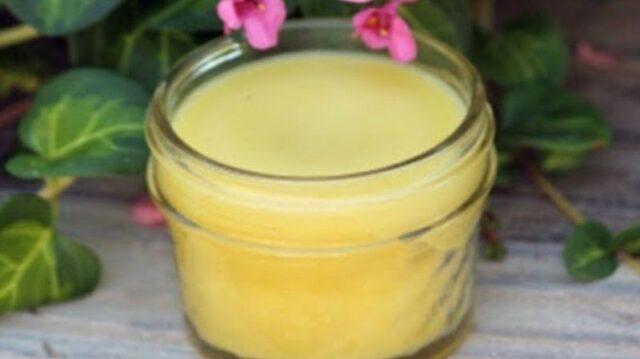
Ointment based on the plant, the wrestler is rubbed into the skin in an amount of not more than 10 g at a time
Application rules
Medicines from aconite are used for joint ailments, colds and oncological diseases. In each case, traditional medicine offers separate treatment regimens.
Tincture of aconite for leukemia
For the complex therapy of leukemia, an alcoholic tincture of a poisonous plant is prepared - a small spoonful of crushed dry root is poured with 250 ml of vodka and kept in the dark for two weeks. The wrestler's treatment algorithm looks like this:
- on the first day, a drop of the drug is diluted in 50 ml of water and taken three times a day on an empty stomach;
- on the second and subsequent days, add another drop of plant tincture for the same amount of liquid;
- upon reaching ten drops, the dosage is stopped and the medicine is taken in a constant volume for ten days;
- then they begin to gradually reduce the amount of alcoholic agent - also drop by drop a day.
When the dosage again reaches a drop of the wrestler's tincture, diluted in 50 ml of water, you will need to take a month break. After that, the course is repeated, and in total it is necessary to go through seven treatment cycles.
Aconite for colds
With acute respiratory viral infections and flu, and especially with a sharp increase in temperature, some time after eating, you must take two small spoons of the usual decoction of the plant. It is best to do this before bedtime, in which case the fever will noticeably decrease in the morning. You need to continue treatment until the high temperature disappears completely.
Tincture of aconite for rheumatism
With an exacerbation of rheumatism, the following remedy is beneficial:
- the root of the fighter in the amount of 100 g is poured into 1 liter of vodka;
- insist in a warm and dark place for three days, shaking occasionally;
- after the expiration of the period, filter the darkened liquid.
Apply a tincture of the wrestler plant externally for rubbing. After the procedure, the sore joints are wrapped in a woolen cloth and go to bed, and in the morning the bandage is removed and the affected area is treated with a cloth soaked in cool water. In total, therapy should be continued for at least a month.
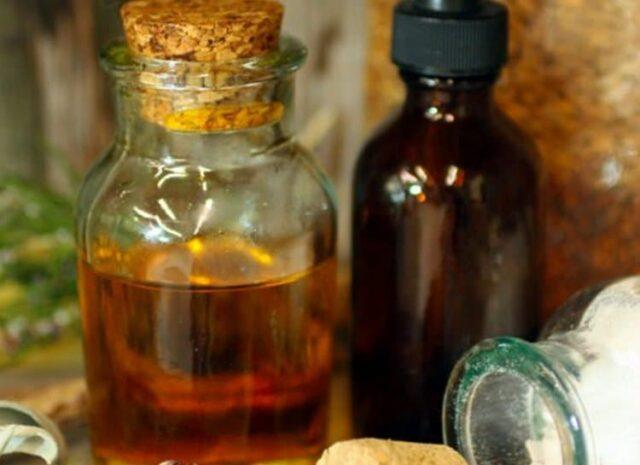
Rub the wrestler's tincture into the skin until it is completely absorbed
Poisoning symptoms and first aid
Even with careful use of aconite according to recipes, an overdose of the plant cannot be ruled out. It can be recognized by the following features:
- profuse salivation;
- sudden redness of the skin, which is quickly replaced by severe pallor;
- photophobia;
- nausea, vomiting and diarrhea;
- pain in the abdomen and heart;
- numbness of the skin;
- shortness of breath and impaired urination.
Such signs appear on average 1.5-2 hours after an overdose by a wrestler. In case of plant poisoning, wolf aconite must immediately induce repeated vomiting until the stomach is completely empty. At the same time, you should drink plenty of clean water, it is useful to take activated charcoal. But the means to stop nausea and diarrhea are strictly prohibited.
Limitations and contraindications
In some conditions, it is impossible to take decoctions and tinctures of the aconite plant in principle - neither by internal nor external methods. Contraindications for a wrestler include:
- pregnancy and lactation;
- individual plant allergy;
- hypertension or hypotension;
- chronic liver disease;
- renal failure;
- acute infectious diseases;
- severe cardiovascular ailments;
- addiction to alcohol and drugs;
- mental illness and malfunctions of the nervous system.
The use of plant-based products is prohibited for children under 18 years of age.
Collection and procurement of raw materials
The wrestler's roots are harvested between August and October. Using a shovel, the whole plant is dug up, the tubers are separated along with thin feeding shoots and washed in cool water. After that, the raw materials are dried in a well-ventilated room or under a canopy until the moisture completely evaporates.
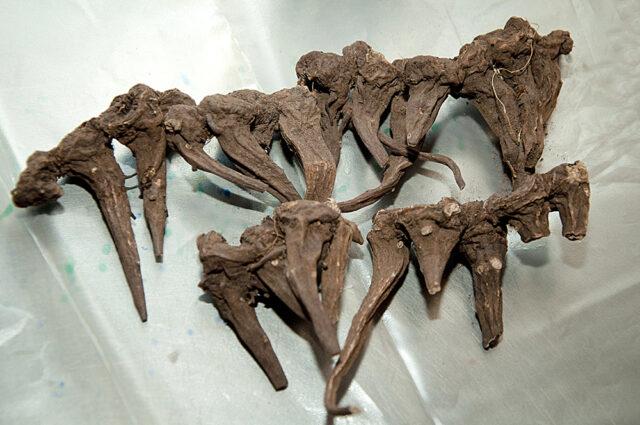
All tools and surfaces after drying the wrestler must be thoroughly washed
Leaves and flowers are harvested in June and July. The green parts are cut with a sharp knife, sorted out and also dried in the fresh air away from direct sunlight. When working with the plant, the wrestler uses gloves.
Store aconite in a glass container in the dark and cool, out of the reach of children and animals. The shelf life of raw materials is two years.
Conclusion
The aconite plant is very poisonous, but if used correctly, it benefits the body.When using a fighter, it is important to observe scanty dosages and follow proven recipes exactly.
